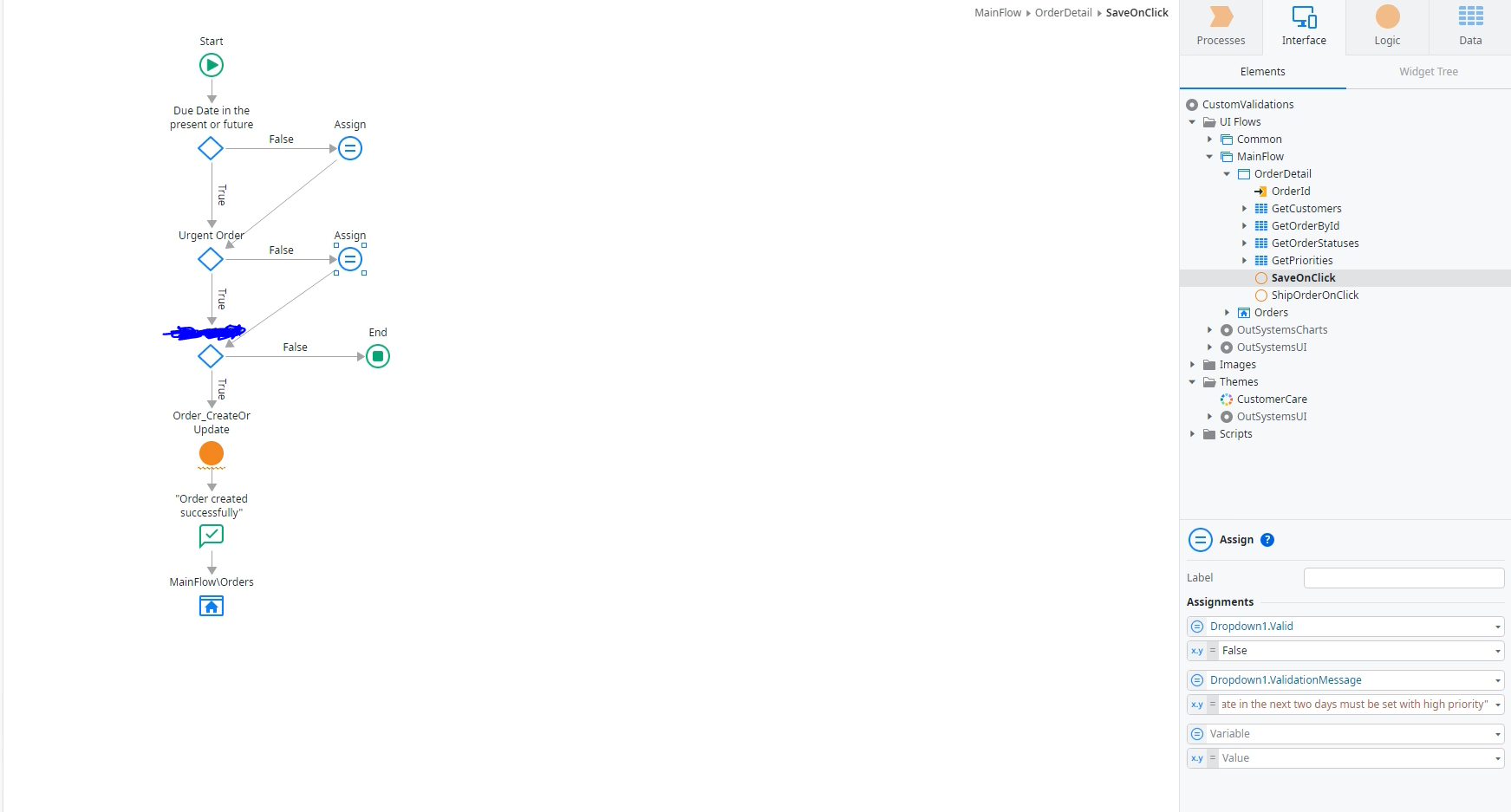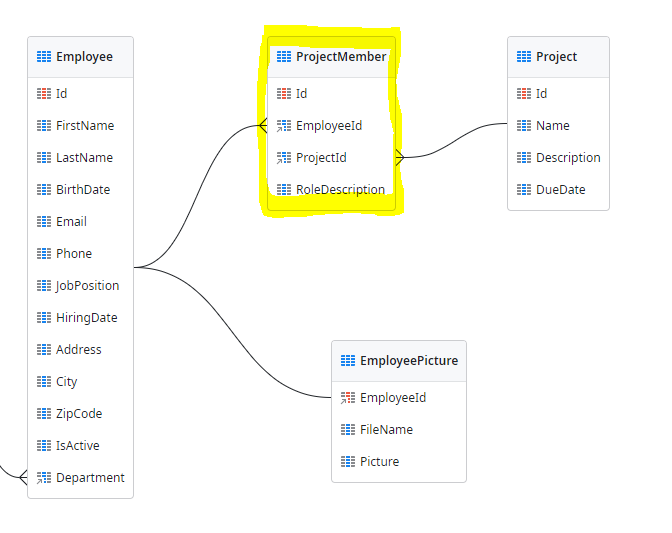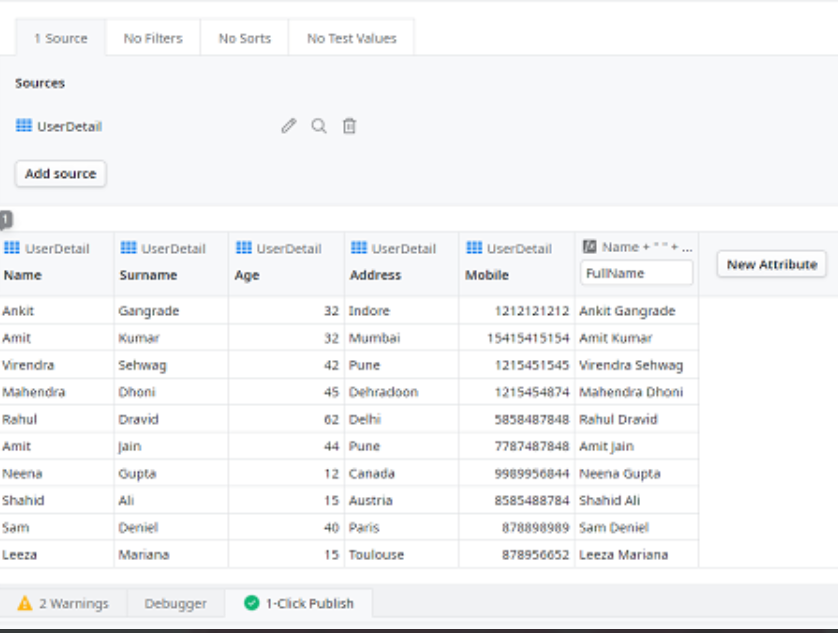Outsystems Prac Test 4
Regarding data relationships, which of the following options is correct?
A reference attribute needs to be mandatory.
An Entity must have an identifier to allow relationships.
An Entity can only have one reference attribute.
The Entity identifier must be an integer.
Regarding the Delete Rule property, which of the following options does not guarantee referential integrity?
Protect
Delete
Ignore
Replace
Regarding Indexes, which of the following options is correct?
Custom indexes cannot be added to an Entity.
Indexes speed up data retrieval without any kind of impact.
Indexes over referenced attributes cannot be deleted.
Unique indexes help prevent data duplication.
Which of the following behaviors does not apply to Forms?
A Form groups input widgets and allows displaying and editing data.
A Form has a Source property that will hold the values submitted by the user.
Besides input widgets, a Form can hold other widgets such as Links and Buttons.
A Form is useful to validate data submitted by the user.
Considering the Dropdown and the Button Group, which of the following options is false?
A Button Group needs a Button Group Item to represent each option that the user will have available to choose from.
The List property of the Dropdown defines the data that will appear as options to a user on a Screen.
Each Button Group Item within a Button Group has a Variable property to save the option chosen by the user.
The Variable property of the Dropdown will hold the value selected by the user. That value is defined in the Options Value property.
What is the Screen behavior when a widget is not valid (Valid property set to False)?
The Screen displays the widget greyed out, and displays the validation error message on the input.
He widget does not appear on the Screen and the validation message appears in its place.
Displays the regular widget, applies a specific styling (e.g. Red border), and displays the validation error message.
Displays the regular widget and displays the validation error message when we hover the mouse.
Which of the following options is correct regarding the Valid property of the Form?
The Valid property of the Form should be checked after the last custom validation.
The Valid property of the Form is automatically changed to False when all the input fields of the Form are not valid.
The Valid property of the Form should be explicitly set to False (e.g. With an Assign) when an input field is not valid.
When built-in validations are enabled, the Valid property of the Form is automatically checked before executing the client action logic.
Considering Users and Roles in OutSystems, which of the following options is correct?
By default, end-users are managed in the built-in Users application
End-users can only be created programmatically, using Actions from the Users application.
There are three built-in roles in OutSystems: Anonymous, AppUser and Registered.
All users, with or without a login, have automatically the Registered Role.
In OutSystems, how do we restrict access to a Screen?
Go to the Users application and associate the Screen to a specific role.
Use the CheckRole Action.
In the Screen Properties, untick roles to restrict their access.
We don't. Only users with a username and password can access.
Considering the built-in Role Actions, which of the following options is false?
The CheckRole Action checks if a user has that particular Role.
The GrantRole Action allows to grant a Role to a user programmatically.
The RevokeRole Action allows to remove a Role from a user programmatically.
The CreateUserWithRole Action creates an end-user and assigns it the Role.

The Following logic represents the creating an order fuction, what should be the last condiction on that if statement .
GetOrderById.List.Current.Order.Status = Entities.OrderStatus.New
Form1.Valid = True
Form1.Valid = False
If(Client.MasterSearch="",True,mem.membership_no like "%" + Client.MasterSearch + "%" or mem.idno like "%" + Client.MasterSearch + "%" or mem.firstnames like "%" + Client.MasterSearch + "%" or mem.surname like "%" +Client.MasterSearch + "%" or com.company_code like "%" + Client.MasterSearch + "%" or com.company_name like "%" + Client.MasterSearch + "%")

What is another name used for the highlighted table
Tangible Entity
Intangible Entity
Junction Entity
Inner Entity
If the Primary key of one entity is also the primary key of another entity then what type of mapping it is forming?
1:Many
1:1
Many:1
Many:Many
If I apply DELETE rule in the Child entity for one of attribute, upon deleting the key row from the Parent table what would happen?
It would not allow deleting as the key is present in the child table
It would allow deleting and nothing will happen to the child record
This is the incorrect scenario
It would delete from parent and associated child records would also be deleted
Consider a built-in validation property of the form, Which of the below-mentioned scenario will keep the form not valid
Date inserted in a text field
Number inserted in a text field
Text inserted in a integer field
Integer inserted in a a decimal field
Considering the CheckRegisteredRole Server Action is defined with function property "YES", which of the following options is true?
Actions would be directly available and used in expression under divs visible property
That action would be available and can be used in an IF condition in a client action
That action would be available and can be used in an IF condition in a server action
All of the above

Which of the attributes are returned by the following aggregate?
The UserDetail entity attributes along with calculated attributes
Not yet defined.You need to add an output structure/Entity to the aggregate
Only UserDetail entity attributes
Only the calculated attribute
What is wrong in respect of LINK widget onClick event?
It can be set to external URLs
It can be set to any screen in scope
It can be set to to current screen
It can be set to public client actions
When the built-in validation is set to true, in which condition form will be submitted?
When the date field is filled with an integer value
When some of the mandatory fields are not filled
When the integer field,is filled with text value
When all non-mandatory fields are not filled
A Screen contains a Form to collect User data. The Form has a Save Button with the On Click property set to a SaveOnClick Action, which sends the data to the server. The developer must ensure that the Action will not send the data to the server when the mandatory Customer data fields have not been filled in. What is the best way to do that?
Set the built-in validations of the save button to yes and check if the form valid property is true
Add custom validations for all input fields,if one fails,set the valid property of that form to false
Set the built-in validations of the save button to yes
Set the built in validations of the save button to yes and add an exception handler flow
If there are 2 entities, User and Group. If one User belongs to only one Group, how can we create the one-to-many mapping between them?
Create a new entity_Group and put the identifer of both user and group in the newly created entity
Create an attribute in Group with datatype as the User identifier
Create an attribute in user with datatypes as Group identifier
Create only with join between them
Which of the option below is true when any of the mandatory input's valid property is false?
The forms valid property will automatically be set to false
We would require to set form.valid property to false
Form.valid will be true
Form.valid will be unchanged
A Form has a button with the Built-in Validations property set to Yes. Which validations are automatically performed when a user clicks the button?
It will check if all the mandatory fields are filled
Check if the mandatory fields are filled and if the data submitted by the user matches the data type expected in the input fields
Check if the mandatory fields are filled in and if the non-mandatory fields that are later used in the logic are also filled
Check if the mandatory fields are filled and if the data submitted by the user matches the data type of the forms data source
If there are 2 entities, User and UserDetail. If one UserDetail belongs to only one User, how can we create the one-to-One mapping between them?
Add a new attribute in user and make its data type as UserDetail identifier
Add a new attribute in UserDetail and make its data type User identifier
Make the datatype the primary key of the user entity to UserDetail Identifier
Make the datatype of the primary key of the UserDetail entity to User Identifier

What is required for One-to-One mapping between the below mentioned two entities?
Create a new attribute in the user entity and set its data type as UserDetailIdentifier
Change the identifier data type of the UserDetail entity to UserIdentifier
Create a new attribute in UserDetail and set its data type as UserIdentifier
Move all the attributes from UserDetails entity to user entity
What is true In respect of Data Action?
It executed before aggregates
It can only be used on start
C
It can not be defined without atleast one output parameter
What is wrong in respect of button onClick property?
It can be set to any screen action
It can be set to any server action
It can be set to any external URLs
It can be set to any screen
Which of the below options can not be used inside an expression?
Both output of server actions and output of data action on the screen
The output of data action on the screen
The output of server actions
Addition formulas of two local variables on the screen

Which of the following is true with respect to the below screen setting?
Only users register with the application can access this screen
No authentication needed
Only users with valid credentials
None of the above
"Vivek" is a user of the ERP application and only has the StoreAdmin Role assigned to him. Which of the following options is correct?
Vivek has access to screens with the registered role checked
Vivek does not have access to screens with the anonymous role checked
Vivek only has access to screens that have the StoreAdmin role checked
Vivek has access to screens that have the Store Admin role checked but not the screens with the registered role
To ensure that the incorrect data doesn’t reach the server, what is to be done? Note: Built-In validation property is set to True?
Form.valid property has to be checked before adding the data to the database
Form.valid property has to be set to false in the action flow
Appropriate logic should be written before sending data to the server
Nothing since there is already a built in validation

Choose the correct option associated with the below ERD?
OrderType can't have SellOrderId attribute
No mapping can be formed between two entities
SellOrder can not have OrderType attribute
OrderType should be a normal entity
The screens can be composed by a combination of several elements called Widgets.
True
False
Which of the following options is correct in relation to the Valid property of the Form?
The valid property of the form must be verified after the last custom validation
The valid property of the form is automatically changed to false when all input fields on the form are not valid
The valid propety of the form must be explicitly set to false
When integrated validations are enabled,valid property of the form is automatcially checked before executing
The Expression widget
Display only static text
Display the calculated text at run time
Display only the results of mathematical expressions
Display server action outputs
Which of the following is not a validation incorporated into OutSystems?
Input field data type
Required fields
Maximum length of text fields
Which of the following steps is necessary to create a many-to-many relationship between Entity A and Entity B?
Set the data type of the identifier attribute of entity B to identifier of entity A
Add a new reference attribute of type identifier from entity B to entity A and a new reference attribute of type identifier from entity B to entity A and a new reference attribute of type identifier from entity A to entity B
Add a new reference attribute of type entity identifier B to entity A
Add a new entity C,with two reference attributes of type entity identifier A and entity identifier B
Considering Inputs and Labels, which of the following options is the correct?
Labels associated with mandatory fields will display a visual cue
Each input must have n associated label
To access the value sent in an input widget,we can simply use InputName.Value
An input widget can only be used for the text data type
The List Action triggers a Screen Action that will have the logic to be executed when sliding.
The List Action triggers a Screen Action that will have the logic to be executed when sliding.
The entity identifier must be an integer
A reference attribute must be mandatory
An entity ,ust have an identifier to allow relationships
Regarding the Delete Rule property, which of the following options does not guarantee referential integrity?
Ignore
Protect
Delete
Get
Which of the following mappings between Outsystems and the database NOT is correct?
Index - Index
Reference attribute - primary key
Attributes-colums
Entities-tables
Which of the following behaviors does not apply to Forms?
Forms have a source property that will contain the values sent by the user
In addition to the input widgets,a form can containother widgets ,such has links and buttons
A form is useful for validating the data sent by the user
A form groups input widgets and allow data to be viewed and edited

What widget is this?
Input
Check box
Text Area
Button group
What is the primary purpose of Role-based Security in OutSystems?
Designing user interfaces
Managing database connections
Controlling user access and permissions
Generating reports
In OutSystems, how are roles typically assigned to users?
Automatically based on their username
Through complex custom code
Manually using the Role Assignment functionality
Roles are not used in OutSystems
Which OutSystems component allows you to define roles and their associated permissions?
User Interface (UI) Builder
Role Designer
Data Connector
Mobile App Generator
What does Data Model Integrity refer to in OutSystems?
Ensuring data encryption at rest
Maintaining data consistency and accuracy within the application's data model
Data backup and recovery procedures
Data access control and user permissions
Which of the following is a common method used to enforce Data Model Integrity in OutSystems?
Allowing direct database access to users
Implementing foreign key constraints in the database schema
Storing sensitive data in plain text format
Ignoring data validation rules
What is the role of Data Validation in ensuring Data Model Integrity?
It ensures data is never modified once stored in the database.
It validates data inputs to ensure they conform to defined rules and constraints.
It is responsible for data synchronization between different databases.
It provides data security through encryption techniques.
Which element in OutSystems is used to create interactive and dynamic forms for web applications?
Service Studio
Silk UI Framework
Entity Diagram
Outsystems Forge
{"name":"Outsystems Prac Test 4", "url":"https://www.quiz-maker.com/QPREVIEW","txt":"Regarding data relationships, which of the following options is correct?, Regarding the Delete Rule property, which of the following options does not guarantee referential integrity?, Regarding Indexes, which of the following options is correct?","img":"https://www.quiz-maker.com/3012/images/ogquiz.png"}
More Quizzes
6 vs. 11 - Cabinet Discounters Tournament
100
Infection Control
1160
Nostalgia Quiz-1
1050
PoC platform user exam
420
Which Anne Frank Personality Are You? Take the
201023952
Can You Ace the Total Drama Island: The Big Sleep?
201060087
Inpatient Psychiatry Sub-Internship
15829583
What Conditions Cause the Contractile Vacuole to Fill with Water?
201087578
Gate Control Theory of Pain - Test Your Knowledge
201040661
Jazz Arranging II
15833873
Environmental Science Related Questions: Test Your Eco IQ
201033873
Ultimate Horse Trivia - Test Your Equine Knowledge!
201045411